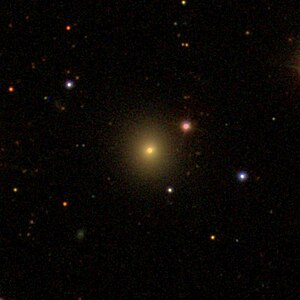IC 1696
| Galaxy IC 1696 |
|
|---|---|

|
|
| SDSS image from IC 1696 | |
| AladinLite | |
| Constellation | whale |
|
Position equinox : J2000.0 , epoch : J2000.0 |
|
| Right ascension | 01 h 24 m 52.3 s |
| declination | -01 ° 37 ′ 01 ″ |
| Appearance | |
| Morphological type | E + |
| Brightness (visual) | 13.6 mag |
| Brightness (B-band) | 14.6 mag |
| Angular expansion | 0.90 × 0.8 |
| Position angle | 10 ° |
| Surface brightness | 13.3 mag / arcmin² |
| Physical data | |
| Affiliation |
Abell 194 WBL 45 |
| Redshift | 0.019547 ± 0.000037 |
| Radial velocity | 5860 ± 11 km / s |
|
Stroke distance v rad / H 0 |
(264 ± 19) · 10 6 ly (81.0 ± 5.7) Mpc |
| history | |
| discovery | Herbert A. Howe |
| Discovery date | January 19, 1900 |
| Catalog names | |
| IC 1696 • UGC 973 • PGC 5231 • CGCG 385-113 • MCG + 00-04-122 • 2MASX J01245237-0137014 • GALEXASC J012452.36-013700.0 • LDCE 89 NED007 | |
IC 1696 is an elliptical galaxy from the Hubble type E1 in the constellation Cetus south of the celestial equator . It is estimated to be 264 million light years away from the Milky Way and about 70,000 light years in diameter.
In the same area of the sky are u. a. the galaxies NGC 519 , NGC 530 , NGC 538 , IC 1693 .
The object was discovered on January 19, 1900 by Herbert Alonzo Howe .
